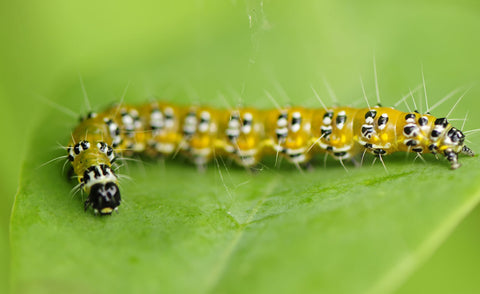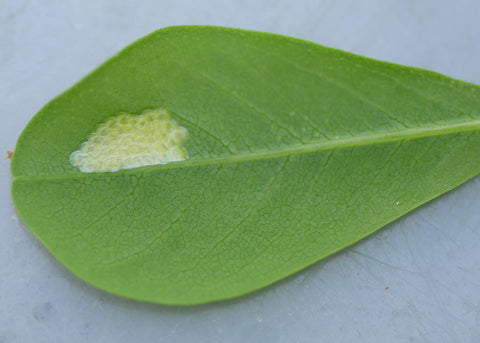Plants in the genus Baptisia, also known as false indigos, are tough and resilient plants that are not typically bothered by pests or diseases. However, one pest is becoming more common in gardens and landscapes and it’s called the Genista Broom moth (Uresiphita reversalis). The caterpillar, or larval stage, of this moth, feeds on some plants in the pea family, which False Indigo is a member of.

While I’m all for attracting insects into the garden, the caterpillar of Genista Broom moth can devour plants down to ground level and they don’t seem to have any natural predators to control their numbers. Fortunately, established false indigo plants readily shoot back out, apparently no worse for wear. Even Baptisia plants that are defoliated year after year return and flower with no noticeable decrease in vigor - a true testament to the durability of this popular plant.
If you have a young, newly planted false indigo plants I recommend protecting them from these caterpillars to give them a strong start. If you’re reading this, it may be too late. If your plant has already been devoured, don’t worry too much as it will likely recover and send up new growth. Frequently checking the undersides of the leaves for either eggs or young caterpillars will alert you to their presence before your young plant is consumed a second time.
What are my options to control them?
The first option for established plants is to do nothing and let nature take its course. This is the perfect course of action for mature plants in meadows and informal gardens, where a temporary empty spot can be tolerated and isn’t as noticeable.
The second option is to physically remove the caterpillars. When they are small and before they spread out over the whole plant, the leaves that they are feeding on can be trimmed off. You can also squish them on the plant, but it requires going back over the plants regularly for missed caterpillars. This is very time consuming especially when there are hundreds of caterpillars and they’re spread out over the entire plant.
The third option is to use a natural pesticide such as Bt (Bacillus thuringiensis). Caterpillars are the only insects that Bt controls. It is applied to plant leaves and must be ingested by caterpillars to be effective. It does not harm beneficial insects or pollinators visiting flowers, but be sure to read and follow the directions on the label. Bt will kill any caterpillar species feeding on the plant, so don’t use it on plants that you want to serve as larval hosts – for example, milkweed (Asclepias species) for monarchs. Using a natural pesticide is the best option for gardeners with limited time who want their Baptisia plants to look presentable throughout the growing season.
Learning to Live with Genista Broom Moth
The chances of the caterpillars returning each year are fairly high, but there are a couple of ways to lessen the impact of this pest in your garden.
Baptisia are showy, easy to grow, and require little if any maintenance. It’s tempting when first discovering their virtues to jump on the plant collector’s bandwagon and plant all the latest varieties. Just remember a healthy garden is all about creating diversity and having a wide variety of different types of plants. The moths are less likely to find a couple of plants tucked in here and there than a large grouping of them.
Since False Indigo emerge and flower early in the season, you could try hiding the empty space by planting late flowering perennials in front of a plant that gets eaten each year. This strategy would allow the Baptisia to flower, then the plant in front would grow up and hide the gap. Some native plants that are good candidates include:
Genista Broom Moth Life Cycle
- In early summer, after Baptisia has flowered, adult moths start laying their eggs, usually on the lower surfaces of leaves
- The yellow clusters of eggs look similar to fish scales and hatch around five days after being laid

- Tiny caterpillars cluster together on young leaves before they spread out over the whole plant
- As the caterpillars grow they create a protective web that surrounds the leaves they’re feeding on

- Caterpillars feed until they reach around an inch in length or have completely eaten their host plant
- They then form a cocoon on the ground under leaf litter or mulch

- The moths are tawny orange in color and about half to three-quarters of an inch in length with a wingspan up to an inch
- They’re only active at night and can occasionally be seen at dusk
- In North Carolina, there are two generations a year while areas further north may only experience one generation per year
- They usually overwinter in the pupal (cocoon) stage
Other Host Plants
In the western regions of the United States, the caterpillars are a pest of Sophora plants and they can also cause damage to soya bean crops. Although they are reported to feed on honeysuckle and crepe myrtle, I’ve never observed any caterpillars on those plants. Other native pea relatives that seem to be safe from damage are: False Indigo-bush (Amorpha spp.), Lupine (Lupinus spp.), and Goat’s Rue (Tephrosia spp.)
